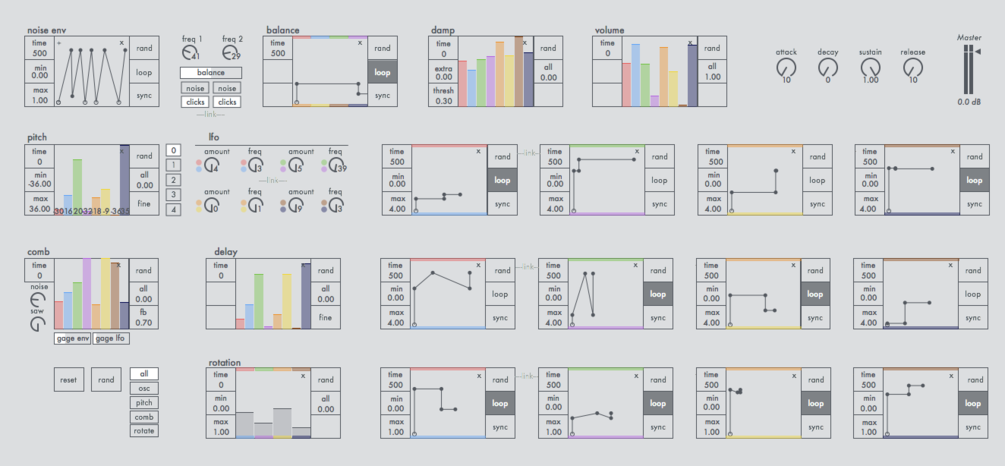Imagine entering an inspiring electronic music studio and getting free reign to play. Now imagine the price of admission for each synth is the cost of a beer.
Tilman Ehrhorn has been rounding out a collection of beautiful instruments for Ableton Live. Not only are they constructed as Max for Live patches, but they’re released under a Creative Commons license (BY-NC-SA) – enough so that you could share your modifications if you want to add your own features. And they’re donationware at €3+ each. There are even some standalone toys, too, in case you don’t have Live Suite or a Max for Live license but do have a Mac.

I’m just going to let him describe them – it’s all up my alley, at least; maybe it’s your jam, too.
*reso is a polyphonic synthesizer built in Max for Live, which sound design is based on simple physical modeling.
Its sound originates from randomly generated clicks or white noise which is passed through a resonator bank.
The circuit of the resonator bank can be adjusted to achieve different results in sound quality.
The gain and frequency of two sound generators can be independently controlled and modulated, furthermore envelopes can be adapted to the individual pitch settings.
It is possible to put some additional reverb on the sounds to improve the pad-like sound quality. The sound can be also individually panned to two different channels (left+right) to achieve a simple spatial distribution.
Further documentation can be found in the Max for Live device if Ableton Live´s Help View is turned on.
Link to download: https://gum.co/XnXnls
*wave is a polyphonic synthesizer built in Max for Live. The generation of sound is based on wavetable synthesis and waveshaping.
Four different waveforms can be loaded or drawn into an editor simultaneously, their levels can be controlled by a matrix. Furthermore several harmonic series can be loaded or manually generated to an oscillator bank to extend the sound spectrum.
Envelopes, LFOs and randomizers can control and modulate various parameters of the sound design.
Link to download: https://gum.co/ukjrj
*string is a polyphonic physical modeling synthesizer built in Max for Live. It is based on a Karplus-Strong algorithm and contains pitch and damping (i.e. filtering) effects.
The sound source consists of four modeled strings whose ‘excitators’ or ‘generators’ originate from white noise or randomly generated clicks.
In the ‘body’ section pitch and filter settings can be set for each string individually. An LFO can be used to modulate individual pitch parameters.
Each of the four modeled strings can be sent to an individual ‘reverberation room’, setting different size and decay times a.o.
Link to download: https://gum.co/rvJla
*pluck is a polyphonic physical modeling synthesizer built in Max for Live, inspired by a Cycling ´74 – gen~ example patch. It is based on a Karplus-Strong algorithm and contains pitch, damping, comb filtering and waveshaping effects.
The sound source consists of eight modeled strings whose excitators originate from white noise or randomly generated clicks. Envelopes, multisliders and LFOs can be used to modulate various parameters for each string individually or in pairs.
Link to download: https://gum.co/Jskx
*speq is a spectral processing audio effect, inspired by a Cycling ´74-tutorial-patch entitled “Forbidden Planet” by Gregory Taylor. It is based on a frequency-domain signal processing technique.The input signal is converted to a frequency-domain signal using the Fast Fourier Transform (FFT) to be processed. The resulting signal is then converted back to a time-domain signal using the inverse FFT (IFFT).
The spectrum to be processed is divided into four sections which can be individually controlled like operating a graphical EQ that can be also randomly modulated by automation.
While every section contains the same maximum number of 32 bands or bins, the FFT’s window size differs in each window, as in the low frequency range even small differences can be heard much more clearly than in the high range (e.g. 50 Hz — 100 Hz = 1 octave | 2000 Hz — 2050 Hz less than one semitone step).
Link to download: https://gum.co/Fsdkw
Ready to train your ears a bit, too, and get better at sight reading? These are macOS-only for now, but if you’ve got a Mac you don’t need Max for Live:
[Key]in is an application made for training and improving your skills in sight reading and ear training.
Link to download: https://gum.co/rDtmS
Ear Trainer is an application made for training and improving your skills in ear training.
It consists of three components
• Interval Trainer
• Triad Trainer
• Tetrad TrainerLink to download: https://gum.co/OPlJo
There’s more, too – check his YouTube channel:
https://www.youtube.com/channel/UCS0cVA3gK93TfYK4WOU9W2w
And website – he’s a Berlin-based “saxophonist, woodwind player, composer, sound designer, producer and musical supervisor”: